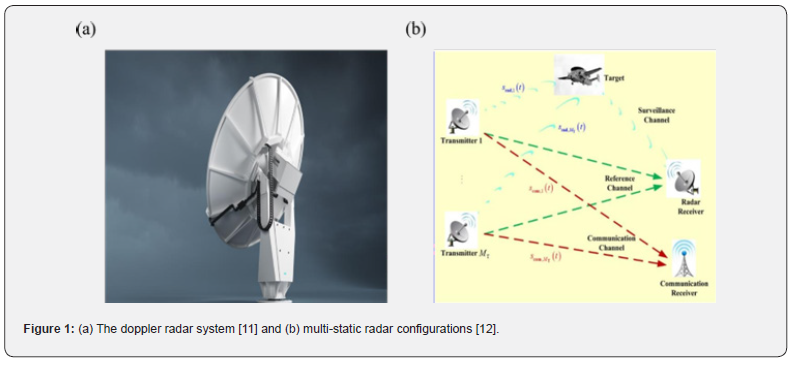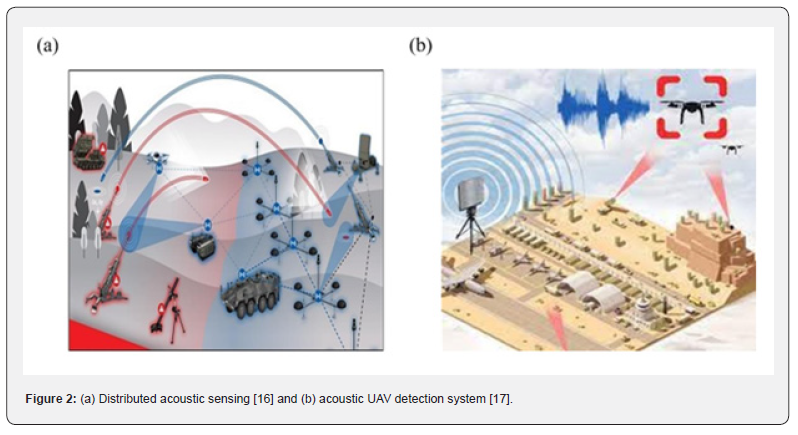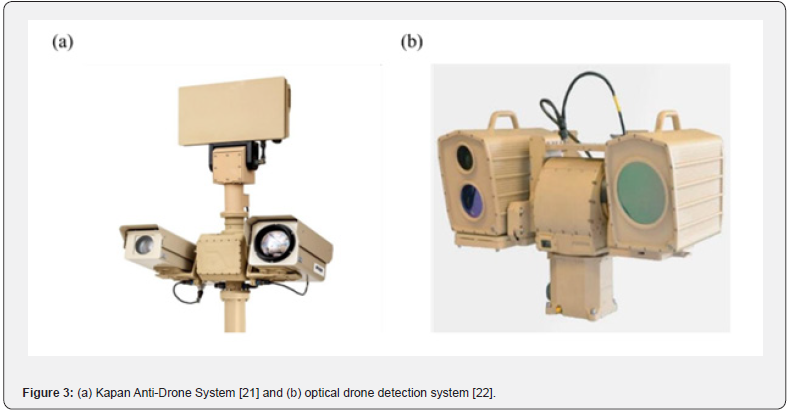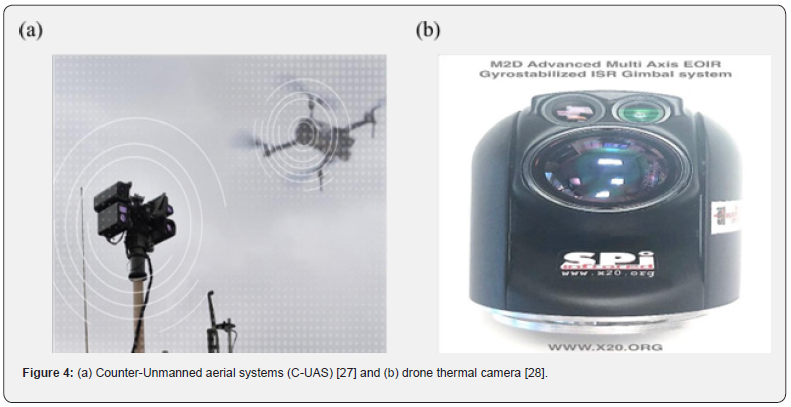A Comprehensive Review of Emerging Techniques for Drone Detection and Identification
Ahmad Fallatah1, Turki Alturki3, Yahya Alsabban3 and Ibrahim Radhwi2*
1Future Mobility Institute, King Abdulaziz City for Science and Technology, Riyadh 11442, Saudi Arabia
2Advance Materials Institute, King Abdulaziz City for Science and Technology, Riyadh 11442, Saudi Arabia
3Artificial Intelligence and Robotics Institute, King Abdulaziz City for Science and Technology, Riyadh 11442, Saudi Arabia
Submission:March 03, 2025;Published:March 13, 2025
*Corresponding author:Ibrahim Radhwi, Advance Materials Institute, King Abdulaziz City for Science and Technology, Riyadh 11442, Saudi Arabia
How to cite this article: Ahmad F, Turki A, Yahya A, Ibrahim R. A Comprehensive Review of Emerging Techniques for Drone Detection and Identification. Robot Autom Eng J. 2025; 6(4): 555688.DOI: 10.19080/RAEJ.2025.06.555688
Abstract
The focus of this study is to provide a comprehensive review of the emerging technologies that have been developed to detect, identify and track drones. The review discusses various technological techniques and applications that include acoustic sensors, Radio Frequency (RF) analysis, radar, sensor fusion approaches, Infrared, and computer vision. The operation principles, advantages and limitations of each application have been highlighted and discussed in detail in this review. The paper also discusses the latest technologies that have been developed in the detection and tracking of drones and the various countermeasures. The challenges faced by the industry and the future research direction in the field, which is rapidly evolving. Legal and ethical issues concerning drone use, detection, identification and tracking have also been discussed to understand the moral and legal implications of the various measures. The paper concludes that there needs to be an integrated system that incorporates various detection technologies to effectively and accurately detect, identify and track drones for improved security.
Keywords: Drone detection; Anti-drone system; UAV
Introduction
Many technological advancements have been witnessed in the recent decades one of them being drones. Drones are also known as remotely controlled Unmanned Aerial Vehicles (UAVs).
These gadgets have been widely adopted in various industries and sectors to perform important tasks. They have been adopted for search and rescue missions, parcel delivery, medicine, law enforcement, construction, topographic mapping, water and forest management, area exploration, power grid inspection and other important tasks in various industries [1]. Drones have also seen widespread usage in the leisure and entertainment sectors as they are simple to use and are more affordable [2]. Nevertheless, there have been increasing challenges emanating from the use of drones which include privacy and danger to other people’s lifestyles and safety. The use of drones whether intentionally or not can lead to the destruction of aircraft if they are ingested into the engines. This could endanger the lives of the pilots and the passengers aboard those aircraft. Reports indicate that there have been many sightings of drones in airports which further complicates the situation making the airports cancel flights as a safety mechanism [1-3]. Most of these drones have been found to unintentionally violate many aviation rules and it is a growing menace in modern society
The menace of drones leading to catastrophic incidents is continually growing which calls for a system of detection and identification of drones to ensure the safety of the people. This is because drones have been widely adopted for civilian and military use further complicating the situation. According to [4], the detection and identification of drones have become a necessity to ensure that the privacy and safety of the people are guaranteed. This is because the drones can potentially be misused and they need to be monitored to ensure that does not happen [5-6]. This paper focuses on a comprehensive review of the emerging technologies and approaches that are being explored in the detection and identification of drones. It reviews the latest approaches and techniques in the detection and identification of drones where the principles, their applications, advantages and limitations are the key focus.
Radar-Based Detection
Radar-based detection is one of the primary methods that has been adopted in the detection and identification of drones. This technology leverages the radar signatures of drones as a way to differentiate them from other forms of airborne objects within their range [7]. In this category, the Doppler radar is one of the radar systems in use as shown in (Figure 1(a)). This system detects the vibrations and the rotational movements of the rotors of the drones [8]. The micro-Doppler analysis in this system is used as a classification system that tells what type of drone it is through the examination of the fine-grained radar returns of the drone [9]. The radar systems are used together with multi-static radar configurations as shown in (Figure 1(b)) below. The multi-static radar configurations adopt multiple transmitters and receivers to enhance the accuracy of drone detection and coverage [10].

One of the challenges facing these systems is that they are not very effective in the detection of small drones. This is because some of the small drones are made of lightweight materials that also have a low cross-sectional area for radar detection and identification [8]. This radar system is also found to be prone to interference from other radio signals making them ineffective in reliably detecting and identifying small UAVs [9]. Radars usually operate by emitting radio waves that are analyzed after they are reflected to the radar systems. As it has been identified, the drones pose a challenge to these systems as they have a small cross-section making the drones unable to effectively analyze their reflected signals. To overcome some of these challenges, recent developments have included phased-array radars together with adaptive signal processing which enhance the capabilities to detect and target track drones. Efforts have also been made to improve the algorithms and longer-range capabilities of the radar systems to enhance the differentiation of drones from other flying objects.
Acoustic Sensing
Another system that is used in the detection and identification of drones is Acoustic or audio sensing. Drones make distinct sounds as they fly which are known as acoustic signatures. This is due to their rotors and the propulsion systems [13]. The technology has been advanced to detect and identify drones where advanced signal processing and algorithms of machine learning are adopted [14]. These acoustic sensing techniques are mostly used in cases where other detection and identification mechanisms such as radar systems and visual technologies are not applicable or obstructed such as in urban settings and forests [15]. The application of acoustic sensing technologies relies on the use of microphones and audio sensors to capture the sounds made by the drones, and process, identify and track the drones as seen in (Figure 2) below. This application may face the challenge of filtering the noise in different environments. To overcome this challenge, advancements have been made through algorithms that filter and reduce noise to improve the detection of drones and tracking them through acoustic sensing. The array processing in these drone technologies also involves the use of microphones to locate the source of the sound and help in tracking the drones. The advancement in these arrays includes the use of a multi-channel processing unit coupled with machine learning to improve the accuracy of tracking systems.

The main challenge in this detection and identification technology is that it has a limited range. In comparison to other techniques, acoustic sensors are limited to a few hundred meters or less. This may hinder the effectiveness of identifying and tracking the drones especially when they are travelling at high speeds [14]. The sensing technology that uses sound has also faced limitations due to the risk of interference from background noises. Wind, traffic and other noises in the environment may increase the chances of failure for the sensors, especially in towns and cities where there is traffic and other sort of noises. The noises may limit the applicability of effectively detecting drones using acoustic sensors [15].

Computer Vision Technique
In the bid to detect, identify and track drones, Computer vision algorithms have been used with promising results [18]. This is the technology that operates by use of video cameras and image processing in the identification, processing and classification of drones based on their visual characteristics. (Figure 3) below show examples of computer vision applications. Computer vision applications rely on the size, shape, and flight patterns to determine the type of drones and to track them [19]. The success of these applications has been recorded on many occasions where computer vision has accurately identified drones among other flying objects [20]. Despite the success identified and associated with this technology, it is limited by the fact that it requires line-of-sight.
The applications need to see the drones through visual resources such as cameras. This might not be always applicable as there may be obstacles such as trees, buildings and other barriers in the environment that obstruct the clear line of sight [19]. The environmental conditions at any given time may also be a barrier to the successful application of computer vision applications. The applications may not be applicable at night and adverse weather conditions that impair vision. This includes times when there is dense fog or smoke. The presence of other moving objects in the area could also affect the accuracy and effectiveness of these technologies [20]. This is because other moving objects could lead to false positives or even missed detections making the applications unreliable.
Infrared (IR) Systems
Infrared systems of drone detection are another technique that is applied in the modern world. These are systems that leverage thermal imaging technology which works by detecting the heat that is emitted by the drones as they fly. The heat emitted by the drones is regarded as the heat signatures of the drone and it is used to detect and identify the type of drones. The heat in this case is classified as infrared as it is not visible to the human eye. The infrared radiations of the drone are captured by special thermal sensors which convert the radiation into visible images. These images are then analyzed and it is successful in identifying heat-emitting objects which is as opposed to computer vision where images are used [23-24].
One of the main advantages of these systems is that they are applicable in all environments including during low-light scenarios. The infrared systems are accurate in all situations as they do not need light but the heat radiation emitted by the drones [25]. Whether the drones are camouflaged, as long as they are emitting heat, they can be identified and tracked by these systems making them very ideal for all-time operations. The systems are also capable of differentiating objects based on heat differences which makes it easier to identify and distinguish drones from other objects. Nevertheless, the infrared applications have various disadvantages.
They cannot identify and assess drone types and other details. This is because they have lowered resolutions as compared to visible light images. The principle of using heat may be prone to false positives in times and environments where there are temperature variations. The other disadvantage of the technology is that it may have limited detection for drones that are made of materials that are heat resistant or have low thermal emission [26]. (Figure 4) are good examples of Infrared drone sensors.

Radio Frequency (RF) Analysis
Radiofrequency emissions have also been used in the detection and identification of drones [29]. The technology involves the monitoring of the wireless control signals and communications modes used by the drones and their operators. A specialized RF analysis technique is adopted in the detection of UAVs. The analysis has been successfully used to extract useful information about the drone such as its model, flight path and the operator [30]. The principle involves an array of scanners and signal analysis systems that detect the different types of frequencies and communication protocols of the drone. The RF signals are also adopted in finding and tracking the location of the drone using multiple antennas that help triangulate the position of the drone by leveraging the RF signals.
Sensor Fusion Approaches
There have been various attempts to ensure the accuracy and reliability of the various drone detection technologies. Considering that there are advantages and limitations of various technologies, many experts have considered sensor fusion approaches where they use more than one technique to ensure increased drone detection [3]. This approach of using more sensor modalities has been referred to as sensor fusion [31]. This application operates by combining sensors such as radar, acoustic, RF sensors and visual techniques to create a hybrid system that can detect, identify and track drones by leveraging all these applications at the same time. This application leverages the strengths ofs each modality and leads to more efficiency and accuracy in drone detection and identification [5]. This is because the different applications complement each other. The data from the multiple sensors is combined to ensure a comprehensive system of drone detection and tracking. This has also been advanced by the use of artificial intelligence which can learn and incorporate data from various applications [2].
Challenges and Future Directions
Despite the various advancements in drone detection, identification, and tracking, various challenges continue to be experienced in the sector [32]. One of the challenges is the complexity of the drone technology. As countermeasures are being advanced, drones are also advanced to evade detection and tracking technologies. There are spoofing and countermeasures designed to make drones undetectable by various technologies. This makes it hard to effectively keep up with the detection and identification of drones [1]. Another issue that has remained to be a challenge is the limitations in identifying drones in various complex environments. For example, the detection of drones in cities has been a challenge as the sensors require line-of-sight or a direct path that they can be detected. This at times becomes a challenge as many obstacles are making it a hard task to effectively detect drones. There are also challenges with the costs involved in the detection and identification of drones where it is hard to ensure that the detection technologies are cost-effective and scalable [33]. There is ongoing research to ensure that some of these challenges are overcome through machine learning and other integrated countermeasures [34]. Some of these technologies include jamming and spoofing where communications between the drone and its operator are disrupted thus neutralizing the threats caused by the drones. Another measure being explored is the use of lasers that can intercept the drones. The principle is the use of kinetic and non-kinetic interceptions where projectiles or even trap nets can be deployed to intercept the drones.
Ethical and Legal Considerations
The use of drones is still a new technology which is being rapidly adopted. The technology when used for surveillance and tracking can raise ethical and legal issues. The safety and privacy of the people may be violated when drones are misused [35]. This calls for regulatory frameworks for the detection and countermeasures. The standards and guidelines for using drones are somewhat indistinguishable because of the struggle of regulatory authorities to keep up with the drone’s technology development [36]. Comprehensive supervision of drone operations is needed especially with cases in which drones can interfere with airports and aerial emergency services [37].
There are also concerns about possible drone misuse for
purposes such as unlawful surveillance, harassment or assault
[38]. To address these concerns, assurance of the accountable
and ethical use of drone technology is required of regulatory
frameworks. Developing sufficient regulatory frameworks and
supervision systems is highlighted by researchers to reduce the
dangers related to misusage of drones.
• To help reduce the dangers related to drone misuse,
regulatory authorities can develop standards and guidelines
for operator training and limitations as well as registration
requirements [39].
• To help reduce unlawful use of drones, regulatory
authorities can deploy security procedures such as geofences and
detect-and-avoid systems.
• To help detect unauthorized drone activities, regulatory
authorities can deploy countermeasures such as drone detection
and interdiction systems [40].
• To improve the capability of preventing threats
associated with drones, regulatory authorities can implement
innovative technologies such as radar systems for detection and
identifying, and signal jamming devices for drone communications
[41].
Conclusion
The emerging technologies for drone detection and identification are evolving at a rapid rate with the bid to address some of the challenges that drones have created such as the safety and privacy of the people. The paper has provided a comprehensive review of the various techniques such as acoustic sensors, Radio Frequency (RF) analysis, radar, sensor fusion approaches, Infrared, and computer vision. None can address all the issues raised. The integration of multisensory technologies can be the best way to approach the countermeasures to ensure that there is effective detection of drones. Nevertheless, there continues to be the challenge of effectively ensuring that all these tasks are handled within moral and legal frameworks.
References
- Mohsan SAH, Khan MA, Noor F, Ullah I, Alsharif MH (2022) Towards the Unmanned Aerial Vehicles (UAVs): A Comprehensive Review. Drones 6(6): 147.
- Taha B, A Shoufan (2019) Machine learning-based drone detection and classification: State-of-the-art in research. IEEE access. 7: 138669-138682.
- Samaras S, Diamantidou E, Ataloglou D, Sakellariou N, Vafeiadis A, et al. (2019) Deep learning on multi sensor data for counter UAV applications-A Systematic Review. Sensors 19(22): 4837.
- Svanström F, Alonso-Fernandez F, Englund C (2022) Drone Detection and Tracking in Real-Time by Fusion of Different Sensing Modalities. Drones 6(11): 317.
- Aledhari M, Razzak R, Parizi RM, Srivastava G (2021) Sensor fusion for drone detection. IEEE 93rd Vehicular Technology Conference (VTC2021-Spring) IEEE.
- Liang T, Zhang T, Yang J, Feng D, Zhang Q, (2022) UAV-aided positioning systems for ground devices: Fundamental limits and algorithms. IEEE Internet of Things Journal 9(15): 13470-13485.
- Wang J, Y Liu, H Song (2021) Counter-Unmanned Aircraft System (s)(C-UAS): State of the Art, Challenges, and Future Trends. IEEE Aerospace and Electronic Systems Magazine 36(3): 4-29.
- Chen VC (2019) The micro-Doppler effect in radar. Artech house.
- Sun Y, Abeywickrama A, Jayasinghe L, Yuen C, Chen C, et al. (2020) Micro-Doppler signature-based detection, classification, and localization of small UAV with long short-term memory neural network. IEEE Transactions on Geoscience and Remote Sensing. 59(8): 6285-6300.
- Mandal S, Mones MD, Das A, Balas VE, Shaw RN, et al. (2021) Single shot detection for detecting real-time flying objects for unmanned aerial vehicle, in Artificial intelligence for future generation robotics 37-53.
- Vaisala (2024) Vaisala Weather Radars.
- Shi C, Wang F, Sellathurai M, Zhou J, Salous S (2019) Low probability of intercept-based optimal power allocation scheme for an integrated multistatic radar and communication system. IEEE Systems Journal 14(1): 983-994.
- Casabianca P, Y Zhang (2021) Acoustic-based UAV detection using late fusion of deep neural networks. Drones 5(3): 54.
- Utebayeva D, Ilipbayeva L, Matson ET (2022) Practical study of recurrent neural networks for efficient real-time drone sound detection: A review. Drones 7(1): 26.
- Lyu C, Zhan R (2022) Global analysis of active defense technologies for unmanned aerial vehicle. IEEE Aerospace and Electronic Systems Magazine 37(1): 6-31.
- Dhananjayan A (2023) Distributed acoustic sensing: Detection of adversary fires through Battlefield Fog!
- Transvaro (2024) Acoustic UAV Detection System.
- Srigrarom S, Sie NJL, Cheng M, Chew KH, Lee M, et al. (2021) Multi-camera Multi-drone Detection, tracking and localization with trajectory-based re-identification. 2021 Second International Symposium on Instrumentation, Control, Artificial Intelligence, and Robotics (ICA-SYMP).
- Kentsch S, Caceres MLL, Serrano D, Roure F, Diez Y, et al. (2020) Computer vision and deep learning techniques for the analysis of drone-acquired forest images, a transfer learning study. Remote Sensing 12(8): 1287.
- Pi Y, Nath ND, Behzadan AH (2020) Convolutional neural networks for object detection in aerial imagery for disaster response and recovery. Advanced Engineering Informatics 43: 101009.
- Global Defence Mart (2021) Kapan Anti Drone System.
- Aero Expo (2024) Speed-MR-Optical Drone Detection System.
- Nithyavathy N, Kumar SA, Rahul D, Kumar BS, Shanthini ER, et al. (2021) Detection of fire prone environment using Thermal Sensing Drone. in IOP Conference Series: Materials Science and Engineering. IOP Publishing.
- He Y, Baoyaun D, Hongjin W, Liang C, Ke Z, et al. (2021) Infrared machine vision and infrared thermography with deep learning: A review. Infrared physics & technology 116: 103754.
- Sneha M, Aravindakshan GA, Vardini SVS, Rajeshwari AD, Sastika RVAR, et al. (2020) An effective drone surveillance system using thermal imaging. in 2020 International Conference on Smart Technologies in Computing, Electrical and Electronics (ICSTCEE).
- Zhang H, Wang C, Turvey ST, Sun Z, Tan Z, et al. (2020) Thermal infrared imaging from drones can detect individuals and nocturnal behavior of the world’s rarest primate. Global Ecology and Conservation 23: e01101.
- Ophiropt (2024) Counter-Unmanned Aerial Systems (C-UAS).
- Spicorp (2024) ULTRA LIGHT EOIR thermal imaging FLIR EO + IR day/night gimbal for manned and unmanned applications.
- Xu C, et al. (2020) RF fingerprint measurement for detecting multiple amateur drones based on STFT and feature reduction. in 2020 Integrated Communications Navigation and Surveillance Conference (ICNS).
- Nie W, Han ZC, Zhou M, Xie LB, Jiang Q (2021) UAV detection and identification based on WiFi signal and RF fingerprint. IEEE Sensors Journal 21(12): 13540-13550.
- Shi C, Lai G, Yu Y, Bellone M, Lippiello V (2023) Real-time multi-modal active vision for object detection on UAVs equipped with limited field of view LiDAR and camera. IEEE Robotics and Automation Letters 8(10): 6571-6578.
- Alhafnawi M, Salameh HAB, Masadeh A, Al-Obiedollah H, Ayyash M, et al. (2023) A survey of indoor and outdoor uav-based target tracking systems: Current status, challenges, technologies, and future directions. IEEE Access 11: 68324-68339.
- Wang P, Wang Y, Li D (2024) DroneMOT: Drone-based Multi-Object Tracking Considering Detection Difficulties and Simultaneous Moving of Drones and Objects. arXiv.
- Lykou G, Moustakas D, Gritzalis D (2020) Defending airports from UAS: A survey on cyber-attacks and counter-drone sensing technologies. Sensors 20(12): 3537.
- Nguyen K, Fookes C, Sridharan S, Tian Y, Liu F, et al. (2022) The State of Aerial Surveillance: A Survey. arXiv.
- Watkins S, Burry J, Mohamed A, Marino M, Prudden S, et al. (2020) Ten questions concerning the use of drones in urban environments. Building and Environment 167: 106458.
- Hassija V, Chamola V, Agrawal A, Goyal G, Luong NC, et al. (2021) Fast, Reliable, and Secure Drone Communication: A Comprehensive Survey. IEEE Communications Surveys & Tutorials 23(4): 2802-2832.
- Majeed R, Abdullah NA, Mushtaq MF, Kazmi R, (2021) Drone Security: Issues and Challenges, IJACSA 21(5).
- Sorbelli FB, Chatterjee P, Corò F, Palazzetti L, Pinotti CM (2023) A Novel Multi- Layer Framework for BVLoS Drone Operation: A Preliminary Study. IEEE INFOCOM 2023 - IEEE Conference on Computer Communications Workshops (INFOCOM WKSHPS).
- Mekdad Y, Aris A, Babun L, Fergougui AE, Conti M, et al. (2023) A survey on security and privacy issues of UAVs, Computer Networks. 224: 109626.
- Mekdad Y, Acar A, Aris A, Fergougui AE, Conti M, et al. (2024) Exploring Jamming and Hijacking Attacks for Micro Aerial Drones. arXiv.






























